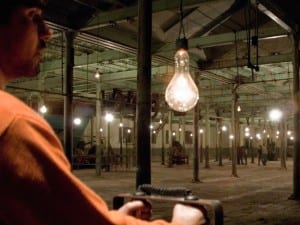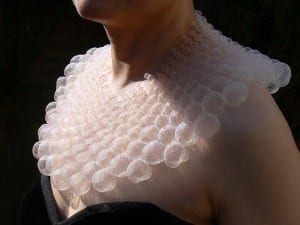The 31st edition of the fair highlights the increasing responsibility we feel for our surroundings, leading to a revival of craft and zero waste.
This year New Designers returns for its 31st edition with 3,000 of the most promising graduate talents from Britain’s leading design courses, with practices ranging from fashion and textiles to motion and digital arts, jewellery and metalwork to illustration and graphic design and product, and industrial design to ceramics and glass. Whilst the main event is curated by course directors and set out much like a trade fair, with budding talents hoping to be scouted by sponsors and buyers, the feature that many visitors set out to see is One Year On. Curated by owner and founder of Shoreditch store Luna & Curious, Rheanna Lingham, this exhibition is a handpicked selection of 60 innovative, entrepreneurial designers chosen for the air and originality of the work developed in their first year of business after graduating.
Split into two four-day exhibitions, showcasing first of all jewellery, contemporary design and crafts, textiles and costume design, with the second run displaying furniture, spatial and industrial product design, and visual communications, Lingham explains that the show “presents an unmissable opportunity to get inspired by fresh ideas and discover new design talent to commission or recruit.” The 2016 edition is dominated by themes of sustainability, zero-waste and cradle-to-cradle making processes, as well as another slightly more surprising practice. Lingham notes: “I would say that this year it just happened that we have amazing ceramics; the selection panel was surprised but you couldn’t discard any one piece just because there were too many entries in this particular form. There is a revival of ceramic making, and it is quite interesting.” A powerful contrast to the previous trends for 3D printed and digitally produced works, this resurgence is both a conscious drive to save a craft which could soon be lost, whilst supporting sustainability. Designs stamped with Made In Britain – advertising their low carbon footprint – have never been so sought after, and accordingly earthy, handcrafted styles with “green” appeal are in vogue. All movements are a reaction to their predecessors, and the gentle and tactile aesthetic of the new ceramics wave is too.
These particular works included in One Year On range from practical homewares to sculptural design feats (porcelain is not the simplest material to manipulate), and incorporate an array of contemporary and traditional processes. For example, Camberwell College of Arts graduate Kate Haywood combines porcelain and textile processes to develop stunning wall pieces inspired by various dances, while UCA graduate Olivia Walker throws round pots in warm clay-fire colours which she then impales with brass rods, creating a fusion of contemporary and traditional aesthetics.
Also reworking traditional ceramics processes is Wendy Ward, whose intricate light fittings play with the translucency of natural porcelain. Sculptural works within the company’s Weave range recall balls of twine, tangled fishing nets or the beginnings of birds’ nests, yet they are in fact constructed by winding ne threads of porcelain together into completely unique entanglements. The main focus of Ward’s work, her Lighting range, instead uses more traditional crafting and sculpting methods to create shades for ceiling lamps that give the impression of hanging blooms, whose petals glow with a warm cream colour once the light switch goes on. Ward explains: “by playing with light and shadow we can create memorable experiences for the user to luxuriate in, producing a unique story for each viewer.” While Wendy Ward’s works are extremely delicate, studio Oscar Copping Ceramics uses the same material to produce heavy-handed forms inspired by the industrial factories of Stoke-on-Trent, once Britain’s ceramics centre. Copping’s work incorporates shapes taken from these pieces of machinery into his Ritual coffeemaker, which rather than ease a faster morning coffee makes the entire process of brewing far more laborious. Copping’s attitude to making is to celebrate the “slow” and describes the Ritual coffee maker thus: “I think that joy and contentment can be found in what many see as mundane everyday tasks. As a maker, interacting with the world through physical tasks is significant to me. A ritual is defined by anything that is done for emotional or practical purposes.”
While Copping is tackling the morning ritual of a smooth cup of coffee, in a different field, Jack Lennie – winner of Designer of the Year 2015 – has been taking on the politics of the daily commute. Lennie’s downloadable, no weld, motorcycle kit named Tinker has been designed not only to be Made In Britain but also to be made wherever in the world the buyer might be situated. Using a range of CAD or CAM machinery, assembled easily using non specialist tools, the buyer can take his or her design to their local garage or workshop, have their Tinker pieces cut out and take them home to assemble, colour and customise as they desire. This removes any need for shipping, drastically decreasing the carbon footprint of the product. Not only is the bike low-waste, it is small, light and compact, and, in its original design, it is also a beautiful piece, with a smooth old-fashioned wooden seat. Lennie’s Tinker is still a prototype, and this is where One Year On can help designers: exposure to possible investors.
Although entirely different in materiality and aesthetic, both Copping and Lennie’s works encourage the user to make a change: slowing down and learning the joy of composing something, whether it be just a co ee or an entire motorbike. These pieces, and the revival of craft in its entirety, reveal a frustration with worldwide acceleration in every area of life and nd methods of alleviating the contemporary desire for speed – even if just on a small, instantaneous and individual basis. “Bespoke”, “unique” and “local” are buzzwords that run the length and breadth of this year’s New Designers, alongside a push for zero-waste. The idea behind zero-waste is that the making process of every new product, regardless of its use, is designed so that production, use and disposal create nothing that will end up in land ll. While zero-waste can often lead products to recycling plants at the end of their lives, the next step up is cradle-to-cradle production, whereby a product is designed with its second lifetime taken into account – for example a coat that might become a sleeping bag, or insulation, once worn out. This is both positive for the world’s ecology and personal economies, as people find that they can consume less and closer to home.
With this in mind, production in general is becoming de-centralised and localised, with ethical and ecological responsibility becoming more significant than economising; furniture design is the area that most epitomises this environmental consciousness within this year’s One Year On. Studios using locally grown wood, manipulated by hand and producing only biodegradable waste, are extremely popular. Husband and wife team, Studio Haran, transform Cornish wood into durable furniture, which is also designed to be easy to disassemble for eventual recycling. Their works celebrate the beauty of natural British woodgrains, hand- rendered into sleek designs, while they also work with the natural properties of the wood: the contemporary coppice dining table for example, whose raw coppiced hazel legs support a toughened glass table top. As coppiced hazel will naturally shrink and warp very slightly, the design is held together by wing nuts which are forced to work with nature in order to accommodate and allow for this movement.
Elsewhere, carpenters Max Bainbridge and Abigail Booth, working under title Forest + Found, hand-turn English oak and use foraged materials to produce long-lasting kitchenware, and hand-embroider and dye cushion covers using non-toxic, natural colourings to develop eco-friendly homeware, while Charles Dedman manufactures wooden furniture using simple design processes that can be outsourced to small carpentry firms. As Dedman’s market grows, he intends to teach his methods to construction firms across the country to localise production and cut the carbon footprint that comes with transporting nished pieces long distances (acting along similar principles as Jack Lennie). Additionally, Dedman’s business encourages craft-based techniques to be taught and practised nationwide, empowering people to build their own environments rather than turning to big businesses.
With this focus on zero-waste, the rising popularity of sustainable fashion brands cannot be overlooked, as in many ways fashion is attempting to lead the way – eliminating toxic dyes, providing a fair wage and incorporating traditional crafts into production. In One Year On this is represented in the work of young designers such as Suzanna James and SEIN: James incorporates the colours and textures of the familiarised landscape into her knitwear, which she describes as “fashion forward wearable art that is the antithesis of throwaway fashion” while menswear label SEIN works in partnership with Zero Waste Scotland to create sustainable unisex garments. Set up by Dan Vo, the studio incorporates both a painstaking process of zero-waste pattern cutting and seamless knitting technology to develop trench coats and simple t-shirts in minimal, elongated silhouettes.
Although designers such as furniture makers Forest + Found or ceramicist Oscar Copping are returning to traditional methods in a statement against mass-production and to encourage a more sustainable lifestyle, it is in the work of designers such as Jack Lennie or SEIN that new technologies oppose becoming a danger to the environment and instead provide innovative solutions that ultimately seek to protect it.
This year’s New Designers and its One Year On showcase make clear how far the relationship between maker and product, beginning with its design and continuing to consider even the end of its life, is growing in intensity. Where fast fashion, flying fads and mass-production once ran hand- in-hand with our own consumer-driven throwaway culture, young designers are encouraging a return to slower making processes that ultimately create objects built sustainably and to last. Demonstrating an insurgence of new ideas and conscientious responses, the show is an example of how far imagination can go in the design world. As curator, Lingham summarises: “I was struck by how many of the exhibitors are creating works that are so demanding in time and skill”, so we just “hope that a morsel of the enthusiasm and excitement of these designers will rub off on us.”
Words Chloe Hodge
New Designers: One Year On. Business Design Centre, London. 29 June – 9 July.




